Pioneers
by Valery Kalishev
I would like to introduce to you Victor Kotov. He is 67 years old now and his interest in cacti started in 1964 after visiting a show of cacti club in Leningrad (nowadays Sankt-Peterburg, the city where he graduated and worked afterwards). He was astonished by the diversity of forms and species of plants about which he had heard but never seen. There were many different books about cacti and journals in German at the show. Being very determined and keen on cacti, Victor wrote down the addresses of cactophyles and nurseries from journals and decided to send letters to all of them right away. Alas, there was no any response. However the passion didn't die but only became stronger. He met foreign students who helped him to order seeds and plants. After 3–4 years he had acquired a great amount of not only seeds which he sow with help of his wife Ludmila but also of rare cacti species, not seen before in the USSR.
In 1970 he and his family moved to Tuapse (Black Sea coast, Northern Caucasia). In the moist climate of Black Sea the cacti greatly changed and started blooming profusely. A great amount of seeds was produced. Plants couldn't fit in the small greenhouse anymore so the second one was built. After 3 years their collection contained about two thousands of different species and varieties of cacti. From that moment they began to hold the expositions of their favourites in Tuapse, Sochi, Krasnodar. Soon the Kotov's collection became well-known to many cactophyles nationwide. Many leading cactophyles of the USSR and foreign visitors signed their guestbook that has been kept ever since.
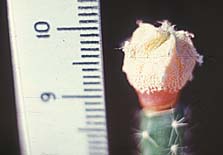 |
| Astrophytum myriostigma f. quadricostata |
They had carried on like that for almost ten years and then the series of misfortunes began. In 1980 the family circumstances forced them to move to a small mountain village. They took the collection with them but contacts with many colleagues were broken. Then few years later the most loyal friend – the wife – passed away. There were problems with children, then after severe frosts a part of collection died. The remaining plants (more than a thousand mature plants that reached flowering size) were turned to a commercial company to be exhibited in various museums of Krasnodar region. But the company turned out to be a dubious one and went bankrupt quickly. After being exhibited in three cities the whole collection perished.
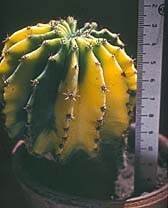 |
| Echinopsis sp. |
In 2000 he ended up back in Tuapse without a single cactus. It seemed non-sense to begin from the scratch in his old age. But also he had a nostalgia and he just wasn't able to live without his favorite cacti. This year he began to build a small greenhouse in the backyard of his house and obtained the first ten cacti.
The Victor's portrait will not be complete without a story about his efforts to produce colored cultivars. He heard about them while living in Leningrad. He even tried to reach master Watanabe who had produced the first colored cultivars. But it didn't work out. Then he buried himself in books and articles about genetics and plant selection. He made contacts with other cactophyles, in particular with Olga Slivkova who specialized in plant selection and helped him with special treatment of cacti seeds. While in Tuapse, sowing the seeds treated by chemical mutagens he started to produce the first colored cultivars. The germination rate was low but there were few thousands seeds sown so the results turned out to be satisfactory.
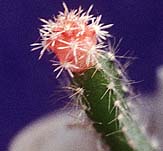 |
| Escobaria sneedii |
After all these years over sixty species of colored cultivars with wonderful color of stem (varying from pearly white, lilac to different hues of red and yellow) were produced and well kept. The experiences with Astrophytum, Mammillaria, Lobivia, Gymnocalycium, Rebutia, Krainzia, Neochilenia were especially successful. From the other genera Turbinicarpus polaskii, Copiapoa kranziana, Cereus peruvianus, Escobaria schnedii should be mentioned. Most of the plants momentarily spread among collections of the USSR cactophyles and even to other countries.
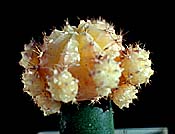 |
| Gymnocalycium mihanovichii |
Victor recalls how in May, 1972, well-known German researcher Walter Haage interrupted his lecture to cactophyles of Leningrad and enthusiastically started to show slides of colored astrophytums given to him by Victor (you can see part of them on photographs).
By the way, this is the first bit of information about producing colored cultivars which I managed to come upon. Moreover it is confirmed by slides. Thereupon I would like to give to Victor Kotov the preference for producing of some cultivars. We didn't manage to find any official bulletins on the topic, so I would like to address editors of cacti journals and other cactophyles to share with us information about producing of cacti cultivars listed below: Neochilenia esmeraldana, Gymnocalycium saglione, Mammillaria wildii, Cereus peruvianus. Astrophytum myriostigma f. quadricostata, Neochilenia sp, Turbinicarpus polaskii, Mammillaria microhelia, Copiapoa krainziana, Rebutia senilis.
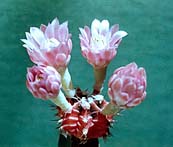 |
| Gymnocalycium mihanovichii |
If there is no such information then we will publish a short description given by Kotov in the "Succulents" journal together with methods and date of producing, photographs. In this particular case the importance is not in the fact that the plants are still alive but that they were produced and the photographs do exist. The chance of their second production is only a matter of time.
In conclusion I would like to thank Russian cactophyles Elena Simonova, Igor Skulkin, Anatoly Mihaltzov, Sergey Malyh, Dmitry Kushelevsky who responded to my call to provide Kotov with seeds and plants. I would like to believe that there are many people not only in Russia who can help him with seeds for the purpose of restoration of his collection and continuing of experiments with colored cultivars. His address:
Victor Kotov, dom 19, per. Izvestkovyj, Tuapse, 352802 Russia.
Translated by Irina Ten





